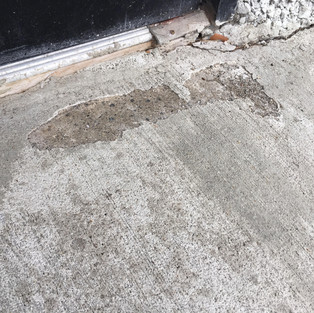The Dirty Little Secret of Concrete Overlays
- Mar 2, 2020
- 4 min read
Updated: Dec 18, 2025
When pool owners research the best way to restore their worn and cracked concrete pool decks, some will mistakenly conclude that concrete overlays are the best solution for renewing the look of the concrete patio and walkway around their pools.
Will concrete overlays provide long-lasting durability? Not by a long shot.
Whether they’re called “stamped concrete overlays,” “cementitious overlays” or by some other name, in the Northeast U.S. these overlays are ill-equipped to withstand the multiple freeze and thaw cycles of colder climates. Down South they’re a popular option, but they still can’t match the integrity of an existing concrete surface that’s been restored to like-new condition.

Concrete overlays for pool decks: It’s only a matter of time before they crack and peel
Consider that overlays are exactly as they sound, thin layers of cement (an eighth of an inch to a quarter inch!) which is sometimes reinforced with polymers or other “magical” ingredients, and then troweled onto the existing concrete surface. The end result is an attractive surface which will make many customers happy—at least for the first few years—and assuming they can get around the aesthetics of a surface that looks artificial and slightly unnatural.
However, it’s after those first few years where problems can begin to arise. Again, the weather in the northeast plays a big part. Because the thin layers of the concrete stamped overlays are minimally adhered to the existing concrete underneath, eventually exposed parts of the overlay will begin to pop off, chip and then peel after just a few freeze and thaw cycles. Once that happens and water gets underneath, the smooth surface that you thought settled your concrete pool deck issues becomes an eyesore and a trip hazard for kids and others playing around the pool.
They look great at first, but after the first winter, the damage is often done. Worst of all: Concrete overlays can't be repaired!
Here’s why stamped concrete overlays chip and peel
In the Northeast, we see clear evidence of thermal expansion and contraction just by driving on the road. Those giant, teeth-shattering pot holes that open up in the road are exhibit A when it comes to the damage that can be caused by freeze and thaw cycles.
The same principles apply to concrete overlays and why they chip and peel. The concrete slab underneath the overlay expands and contracts at one rate (determined by the thermal expansion coefficient), and the overlay on the concrete expands and contracts at a slightly different rate (due to a different thermal expansion coefficient). So while the overlay may look pretty from above, it’s simply not tough enough to cling to the slab underneath as it shifts due to the rhythms of Mother Nature.
In the end, the overlay has no other choice but to separate from the concrete beneath it. The tell-tale sign of imminent failure is the first “crunch” under your feet, which is evidence of weakness in the overlay and a likely spot that will begin to peel as the weather shifts and poolside traffic aggravates the weak spot. Soon, you’ll be able to literally peel the surface off where the weakness has occurred.
From bad to worse: Above a cementious overlay zoomed in. Moisture and mold creep underneath the overlay and de-laminate it from the concrete slab.
Can a stamped concrete overlay around a pool deck be repaired?
Once stamped concrete overlays begin chipping and peeling, there is no fix or patching product that can make spot repairs that match the surface color of the overlay. Not only will a patch look unsightly, it will not be able to mitigate the problems that caused the cracking and peeling in the first place. Consider the following:
Concrete overlays are not repairable to any long-lasting effect.
Concrete overlays around a pool are toast if the concrete below the overlay ever cracks or shifts, the overlay is captive to the problems beneath it.
Patching is a visually intrusive option that is not durable and will not match the color of the original overlay.
There is no silver-bullet fix for a concrete overlay that is cracking and peeling.
Removing a damaged overlay could cost as much as installing a new concrete overlay. Why bother with concrete overlays in the first place?
RenuKrete Engineered Concrete Flooring (ECF) is a superior choice to concrete overlays.
When you’ve spent a significant sum on your backyard haven and pool to entertain family and friends, an unsightly patio and pool deck that’s peeling before your very eyes is a huge disappointment and embarrassment. The best option is to remove the overlay all together and start over. Or never use an overlay in the first place.
Unlike decorative overlays and concrete stamping that can ultimately chip and peel off, RenuKrete ECF is sculpted from the existing concrete deck and crafted into stone formations resembling natural flagstone and slate tile. Even concrete pool decks that are fractured with cracks and uneven expansion joints can be made to look new as if the wear and tear never existed.

RenuKrete is…
Created from the existing concrete deck. There’s no demolition or replacement of old concrete, saving money and carbon output.
Not an overlay. It won’t chip and peel away in a few years like overlays can.
Better than pavers for pool deck applications. It won’t shift or sink over time.
Authentic. RenuKrete maintains the natural texture of your deck and gives it the look and feel of natural stone.
Cutting through the clutter of pool deck renovation options is not as easy as it might seem. None of the other options, however, can come close to competing with RenuKrete for durability, low maintenance, and sustainability – which makes RenuKrete the best choice above all.


























Comments